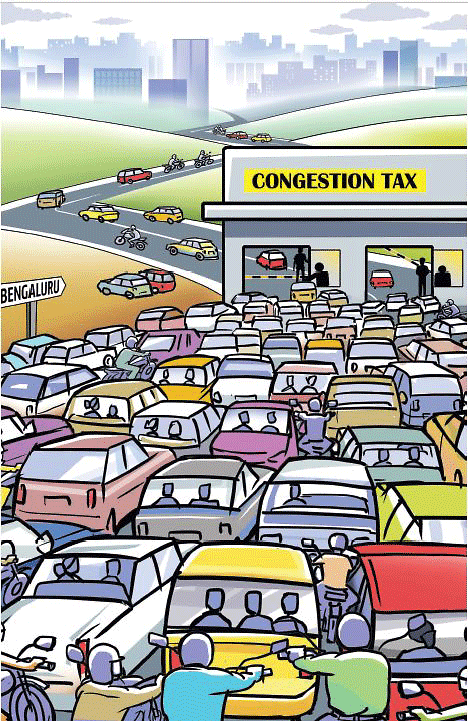For years, traffic and mobility think-tanks had suggested a strategic intervention to decongest at least the inner city roads: A hefty congestion tax to dissuade private vehicles from clogging the roads. Finally getting serious, a draft Comprehensive Mobility Plan (CMP) has now proposed such a tax.
Drafted by the Infrastructure Development Corporation (Karnataka) Ltd, the CMP links a camera-based congestion pricing with demand and location-based parking fees. But the congestion fee, at least in its initial avatar, will be limited to specified peak hours on specified arterial and major roads.
To make the fee collection entirely unobtrusive, the Plan proposes use of appropriate telemetry and camera-based detection technology. This could imply the already tried and tested Automatic number plate recognition technology. The congestion fee will be deducted from bank accounts that are linked to the vehicle while registering.
BBMP role
The Bruhat Bengaluru Mahanagara Palike (BBMP) will be tasked with fee collection. Here’s the CMP rationale: “BBMP should be responsible for levying the congestion fee, as it has the primary mandate of maintaining urban roads.”
However, the Transport Department will enforce the system. The Department, says the CMP, “has the database of registered vehicles and it is the government interface for vehicle owners for all matters vehicle- related.” To enable the levy and collection of the fee, amendments will be required to the Karnataka Municipal Corporation Act, 1976 and the Karnataka Motor Vehicle Taxation Act, 1957.
The CMP has also proposed a Bengaluru Mobility Management Authority to help the coordination between BBMP and Transport Department and establish the required IT system.
Parking policy
Besides congestion pricing, urban mobility and transport experts have always talked about introducing a well-structured parking policy with high fees. The city’s Additional Commissioner of Police, Traffic, Ravikanthe Gowda had also articulated the need for such a policy to address multiple issues linked to illegal and haphazard parking, and limited parking slots being occupied for long hours.
Can the policy work in a city that is used to free-parking for years now? Here’s what the CMP proposes: “High and graded parking fee, based on the location, reflecting the economic cost of parking infrastructure.”
The revenue thus generated will fund infrastructure development for alternate and sustainable modes such as pedestrian/cycling and public transport. The Plan also proposes that the money be used to implement other travel demand management measures that could help reduce reliance on private vehicle usage.
Linkage with BPL
A well-planned execution of the congestion tax and parking policy could sync well with the Bus Priority Lane (BPL), now underway along the Outer Ring Road (ORR). In fact, the Bangalore Metropolitan Transport Corporation (BMTC) had pushed for congestion tax in the city’s hi-density corridors at a public consultation meeting on BPL in October.
Besides the ORR, the city’s hi-density corridors where peak hour traffic jams could extend to two to three hours include: Old Madras Road, Kanakapura Road, Tumakuru Road, West of Chord Road, Old Airport Road, Hosur Road, Sarjapur Road, Ballari Road, Bannerghatta Road, Magadi Road and Ballari Road.
In cities across the world, where congestion tax has worked well, the system is essentially in force inside the Central Business District (CBD). But mobility analysts say Bengaluru’s growth pattern does not adhere to a single CBD. Multiple CBDs mean a linear exercise may not work well.
Impact potential
The system will have an impact even if applied to a few select high density corridors, notes Dr Ashish Varma, Associate Professor, Transportation Systems Engineering at the Indian Institute of Science (IISc). “The push for congestion tax appears to be good thinking. Different cities have applied it differently. It only depends on the evaluation and understanding of the congestion issue.”
So, how steep should the congestion tax be to dissaude people from taking out their private cars? “The level of the charge should be that it substantially reduces the gain in using a private mode of transport. The tax should make it less viable,” Varma explains.
It is not a question of how much tax a private car user is willing to pay. It is about discouraging him totally. But Varma adds that the congestion pricing should be introduced along with a bundle of other measures such as infrastructure development, that makes cycling, walking and public transport more attractive.
CMP questioned
Looking beyond what the CMP says, Vinay Sreenivasa from the Bus Prayanikara Vedike questions the basis of a Mobility Plan without a Master Plan for the city. “We have suffered a lot from this adhocism. Mobility cannot be seen independently of livelihoods and housing. It will trigger chaos,” he elaborates.
Simply put, the question is this: If you don’t know where you are going to build your neighbourhoods, where your work clusters are, how can you come up with a mobility plan? For the record, the Revised Master Plan 2031 (RMP 2031) is still in its draft stage.
The Mobility Plan without a master plan would mean chaotic retrofit solutions such as the Metro link after the Electronic City came up. The entire city will have to be rewired, notes Sreenivasa. “Also, why is the BMRCL and DULT making the plan? Why are elected representatives and ward committees not involved in the process?” he wonders.
Still in its draft stage, the CMP is now open for public consultations. Citizens, particularly the long suffering commuters, are bound to offer their feedback based on real, every day experiences. The Plan’s potential to decongest the city will depend a lot on how these inputs are incorporated and its linkages with a comprehensive master plan.
